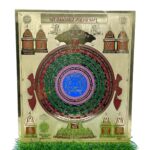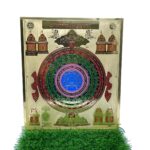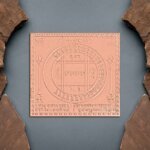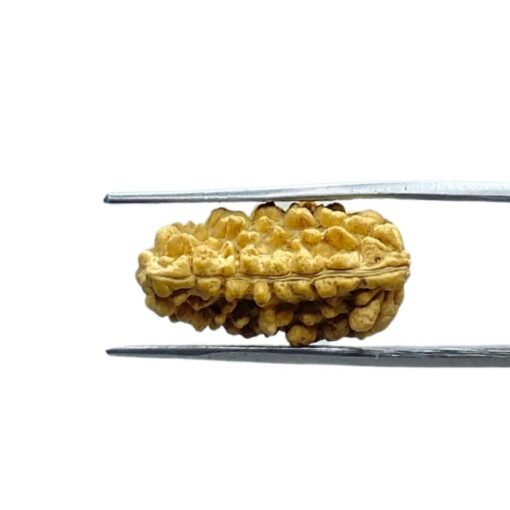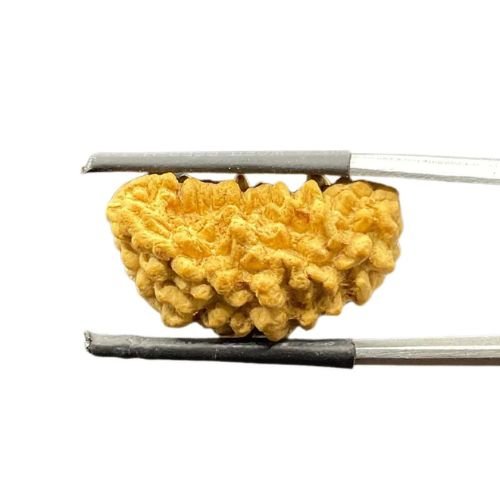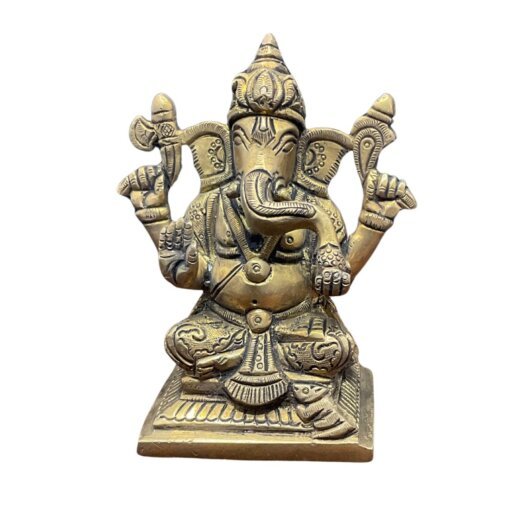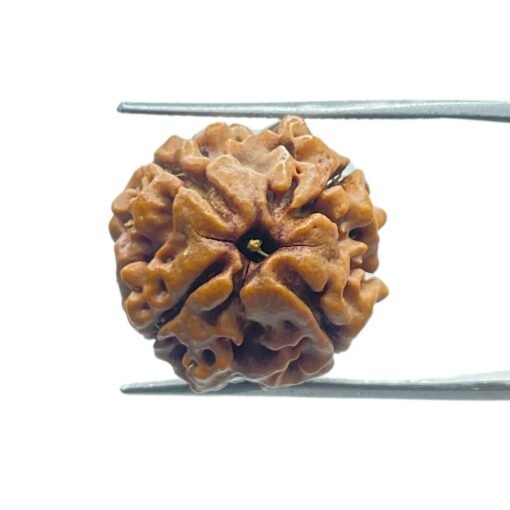Currency
Jain Visthanak Yantra 7″ by 9″ Coloured Gold Plated
Sale
[product_gallery_shortcode device="mobile"]
- Jain Vis sthanak Yantra is made of pure brass with the color gold.
- Size – 7″ by 9″
- Made of Heavy gauge
Original price was: ₹3,300.₹2,102Current price is: ₹2,102.

Get 3% Discount on Prepaid Orders
1 in stock
What Our Customers Are Saying
The Jain Visthanak Yantra is a significant cosmological and meditative diagram in Jainism, representing the structure of the universe and the path to liberation (moksha). Rooted in Jain metaphysics and philosophy, the yantra serves as a visual guide for spiritual progress, illustrating the intricate layers of existence and the soul’s journey through different realms.
At its core, the Visthanak Yantra symbolizes the concept of “Lok,” or the universe, which is divided into three primary regions: Urdhva Loka (upper world), Madhya Loka (middle world), and Adho Loka (lower world). The middle world is where humans reside and where liberation is attainable. The diagram also reflects the six dravyas (substances) of Jain ontology — soul (jiva), matter (pudgala), motion (dharma), rest (adharma), space (akasha), and time (kala) — forming the metaphysical basis of the universe.
The term “Visthanak” refers to stages or places of progression, often linked to the soul’s purification process. The yantra is not merely decorative; it is a sacred tool for meditation, helping practitioners focus on the nature of reality, karma, and the steps necessary to transcend the cycle of birth and death (samsara). In some traditions, it is used during rituals and spiritual practices to align the mind with Jain ethical principles such as non-violence (ahimsa), truth (satya), and non-possessiveness (aparigraha).
Benefits Of Jain Visthanak Yantra
The Jain Visthanak Yantra is a symbolic and ritual tool used primarily in Jainism, especially within certain sects for spiritual and meditative practices. It’s not as universally known as other yantras (like the Shri Yantra in Hinduism), but it holds important meaning in Jain metaphysics and cosmology.
- Spiritual Focus and Meditation Aid
- It helps the practitioner concentrate during samyak darshan (right perception) and dhyana (meditation).
- Used as a visual representation of the path to liberation (moksha) according to Jain philosophy.
- Represents the Jain Universe
- The yantra often symbolizes the structure of the universe (Loka), including the realms of heavenly beings, humans, and hellish beings.
- It reflects the siddhashila, the zone where liberated souls reside.
- Guidance on the Path to Liberation
- Acts as a philosophical map: The different parts of the yantra represent various stages of spiritual evolution and karmic states.
- Reinforces the concepts of non-violence, truth, non-possessiveness, etc.
- Used in Religious Rituals
- Invoked during Puja, Paryushan, and Samvatsari for spiritual cleansing and karmic purification.
- Seen as a sacred diagram to invite auspicious energies.
- Mental and Emotional Benefits
- Provides a sense of inner peace, clarity, and purpose when used with devotion.
- Reinforces moral and ethical living, aligning one with Jain principles.
-
Cultural and Educational Tool
- Teaches complex Jain concepts through symbolism and geometry, making abstract ideas more accessible.
-
Used by Jain monks and scholars to explain metaphysical structures to lay followers.
Benefits Of Jain Visthanak Yantra In Hindi / ( जैन विस्थानक यंत्र के लाभ हिंदी में )
जैन विष्ठानक यंत्र एक प्रतीकात्मक और आध्यात्मिक उपकरण है, जिसका उपयोग मुख्यतः जैन धर्म में किया जाता है, विशेष रूप से कुछ संप्रदायों द्वारा ध्यान और साधना के लिए। यह श्री यंत्र जैसे अन्य यंत्रों जितना व्यापक रूप से प्रसिद्ध नहीं है, लेकिन जैन दर्शन और ब्रह्मांड विज्ञान (कॉस्मोलॉजी) में इसका विशेष महत्व है।
आध्यात्मिक एकाग्रता और ध्यान में सहायक
-
यह यंत्र साधक को सम्यक दर्शन (सही दृष्टिकोण) और ध्यान में केंद्रित रहने में मदद करता है।
-
मोक्ष (मुक्ति) की ओर जाने वाले मार्ग का दृश्य प्रतीक होता है।
जैन ब्रह्मांड की संरचना का प्रतीक
-
विष्ठानक यंत्र में जैन ब्रह्मांड (लोक) की संरचना को दर्शाया जाता है, जिसमें स्वर्ग, मनुष्यलोक और नर्क के क्षेत्र शामिल होते हैं।
-
सिद्धशिला (जहाँ मुक्त आत्माएँ निवास करती हैं) का भी इसमें चित्रण होता है।
मोक्ष मार्ग की दिशा में मार्गदर्शन
-
यह यंत्र एक दार्शनिक नक्शे की तरह कार्य करता है – इसके विभिन्न भाग आत्मा की आध्यात्मिक उन्नति और कर्मिक अवस्थाओं को दर्शाते हैं।
-
यह अहिंसा, सत्य, अपरिग्रह जैसे मूल जैन सिद्धांतों की पुनः स्मृति कराता है।
धार्मिक अनुष्ठानों में उपयोग
-
पूजा, पर्युषण और संवत्सरी जैसे पर्वों के दौरान इसका प्रयोग आत्मशुद्धि और कर्मों की शुद्धि के लिए किया जाता है।
-
इसे एक पवित्र चित्र के रूप में देखा जाता है जो शुभ ऊर्जा को आकर्षित करता है।
मानसिक और भावनात्मक लाभ
-
यदि श्रद्धा के साथ प्रयोग किया जाए, तो यह आंतरिक शांति, स्पष्टता और उद्देश्य की भावना प्रदान करता है।
-
यह नैतिक और सदाचारी जीवन को प्रोत्साहित करता है, जिससे व्यक्ति जैन मूल्यों के अनुरूप जीवन जी सके।
सांस्कृतिक और शैक्षणिक महत्व
-
जैन धर्म के जटिल सिद्धांतों को प्रतीकों और ज्यामितीय रचना के माध्यम से सरलता से समझाने में सहायक होता है।
-
जैन साधु-साध्वी और विद्वान इसका उपयोग आम लोगों को जैन ब्रह्मांड और मोक्ष मार्ग को समझाने के लिए करते हैं।
How To Worship Jain Visthanak Yantra / ( जैन विस्थानक यंत्र की पूजा कैसे करें )
1. Cleanliness & Purity
-
Take a bath and wear clean, preferably white or saffron clothes.
-
Choose a clean and quiet place for the puja.
2. Placement of the Yantra
-
Place the Visthanak Yantra on a clean cloth or a small wooden platform (chowki).
-
It should face east or north.
-
Light a diya (lamp) and incense stick (dhoop) in front of it.
3. Offerings (Upacharas)
-
Offer fresh flowers (white or red), rice grains, sandalwood paste, fruits, and sweets (preferably sattvic or Jain-compliant).
-
Some practitioners also offer Akshata (unbroken rice mixed with turmeric or sandal paste).
4. Sankalp (Intention)
-
Sit in Padmasana or Sukhasana, close your eyes, and take a few deep breaths.
-
Mentally invoke Arihants, Siddhas, Acharyas, Upadhyayas, and Sadhus (Pancha Parmesthi).
-
Set your intention or prayer (health, peace, success, spiritual upliftment, etc.).
5. Chanting the Mantra
Use the main mantra associated with the Visthanak Yantra. One commonly used Jain mantra for this yantra is:
“Om Hreem Kleem Namah”
or
“Om Rhim Namo Arihantanam”
-
Chant it 108 times using a Rudraksha or Lotus mala.
-
Focus your mind on the center point (bindu) of the yantra while chanting.
6. Meditation
-
After chanting, meditate silently on the yantra.
-
Visualize light and energy radiating from it and blessing you.
-
Reflect on Jain values: Ahimsa (non-violence), Satya (truth), Aparigraha (non-possession).
7. Aarti & Prarthana
-
Perform a simple Jain Aarti or recite the Kshamavani (forgiveness prayer) at the end.
-
Bow down and offer thanks.
| Weight | .500 kg |
|---|
Q & A
Ask a question
There are no questions yet
FAQS
1. Are Rudrapuja products genuine and certified?
Yes — Rudrapuja guarantees authenticity and offers XRAY-certified Rudraksha beads, ensuring that each product is genuine and lab-validated.
2. Do you offer worldwide shipping?
Absolutely! We provide fast international shipping, with delivery typically within 5–12 business days after dispatch.
3. Is Cash on Delivery (COD) available?
Yes — We offer Cash on Delivery across India, along with free shipping options.
4. What is your return policy?
You have 10 days from the date of delivery to return an item, provided it’s unused and in its original condition.
5. How does Rudrapuja ensure product authenticity and quality?
We strictly deal only in genuine products, and each Rudraksha is lab-certified to maintain the highest standards.
6. Where can I find more FAQs about Rudraksha, their selection, and benefits?
Visit our dedicated FAQ page for detailed answers on selecting Rudraksha beads, their benefits, meditation usage, and more.
7. How can I contact Rudrapuja for support or custom offerings?
You can reach us via WhatsApp, phone, or email. Details are available on our "Contact Us" page and site header.
8. Why Buy from Rudrapuja?
At Rudrapuja, we promise 100% genuine products with an authenticity certificate. We source every Rudraksha bead to ensure freshness and purity. Our Vedic Yantras are crafted strictly as per the Puranas. We focus on understanding customer needs, solving their challenges, and offering authentic quality at the best price.



















